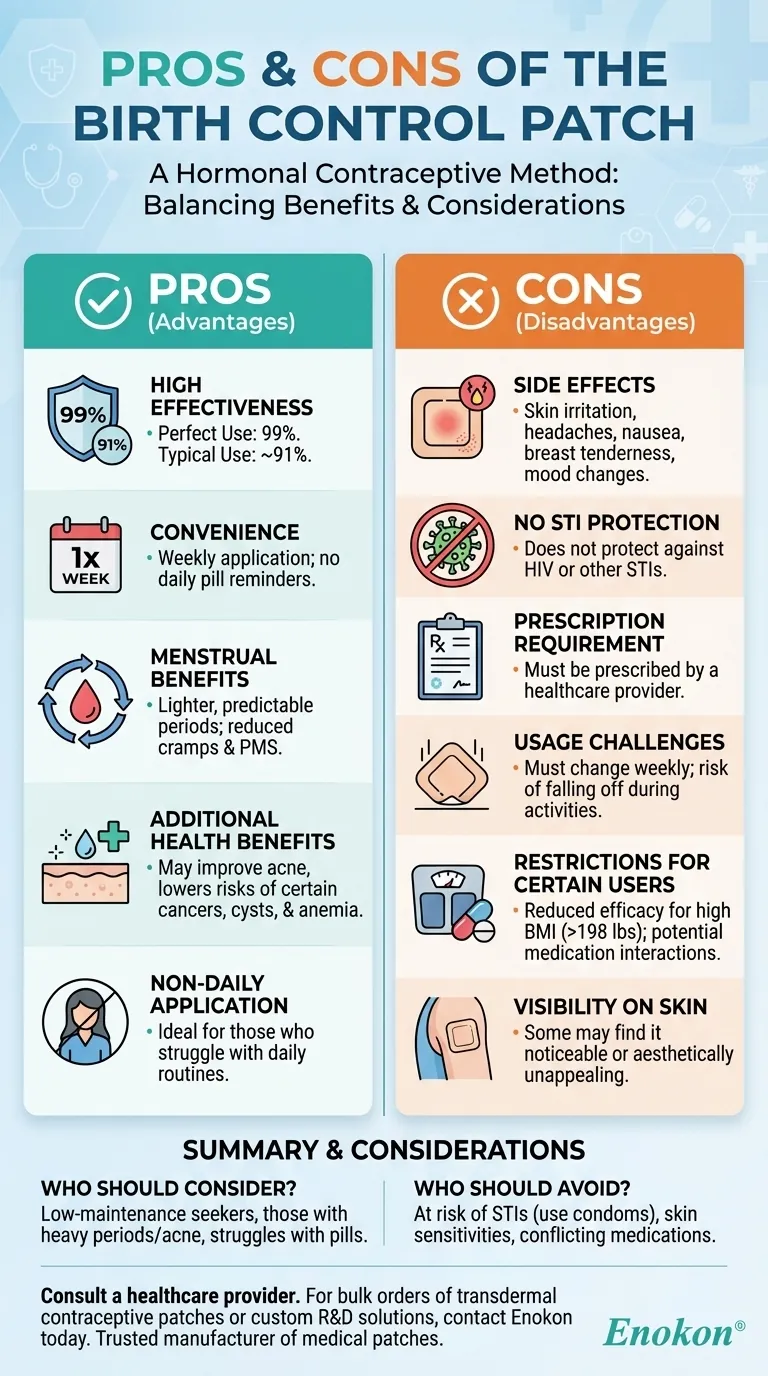The birth control patch is a hormonal contraceptive method that offers both advantages and disadvantages. It provides high effectiveness (99% with perfect use, 91% with typical use) and convenience by requiring only weekly application instead of daily pills. Benefits include lighter and more predictable periods, reduced menstrual cramps, and potential improvements in acne and PMS symptoms. It also lowers risks of certain cancers, ovarian cysts, and anemia. However, drawbacks include possible side effects like skin irritation, headaches, nausea, and breast tenderness. The patch doesn't protect against STIs, requires a prescription, and may not be suitable for individuals with a high BMI or those taking certain medications. Proper usage is crucial, as forgetting to change it weekly reduces effectiveness.

Key Points Explained:
Pros of the Birth Control Patch
-
High Effectiveness
- With perfect use, it is 99% effective in preventing pregnancy; typical use is around 91%.
- Comparable to other hormonal contraceptives like the pill or ring.
-
Convenience
- Applied once a week, eliminating the need for daily pill reminders.
- Can be removed when no longer needed, offering flexibility.
-
Menstrual Benefits
- Regulates cycles, making periods lighter, more predictable, and less painful.
- Reduces symptoms of PMS (premenstrual syndrome).
-
Additional Health Benefits
- May improve acne due to hormonal regulation.
- Lowers risks of ovarian cysts, endometrial and ovarian cancers, and ectopic pregnancy.
- Reduces iron deficiency (anemia) by decreasing blood loss during periods.
-
Non-Daily Application
- Ideal for those who struggle with daily pill routines.
Cons of the Birth Control Patch
-
Side Effects
- Common issues include skin irritation, headaches, nausea, breast tenderness, and mood changes.
- Some users report weight gain or breakthrough bleeding.
-
No STI Protection
- Unlike condoms, it offers no protection against HIV or other sexually transmitted infections.
-
Prescription Requirement
- Must be prescribed by a healthcare provider, which may limit accessibility.
-
Usage Challenges
- Must be changed weekly; forgetting reduces effectiveness.
- Risk of falling off, especially during activities like swimming or intense exercise.
-
Restrictions for Certain Users
- Not recommended for individuals with a high BMI (over 198 lbs) due to reduced efficacy.
- May interact poorly with medications like certain antibiotics or anticonvulsants.
-
Visibility on Skin
- Some users may find the patch noticeable or aesthetically unappealing.
Who Should Consider the Patch?
- Those seeking a low-maintenance hormonal contraceptive.
- Individuals with heavy or painful periods, acne, or PMS.
- People who struggle with daily pill regimens.
Who Should Avoid It?
- Those at risk of STIs (should use condoms alongside the patch).
- Individuals with skin sensitivities or allergies to adhesive materials.
- People taking medications that interfere with hormonal contraceptives.
For those considering the estradiol td patch, it’s important to weigh these pros and cons with a healthcare provider to determine if it aligns with personal health needs and lifestyle.
Summary Table:
| Pros | Cons |
|---|---|
| 99% effective with perfect use (91% typical) | Possible side effects (skin irritation, headaches) |
| Weekly application (no daily pills) | No STI protection |
| Lighter, predictable periods | Requires prescription |
| Reduces cramps, PMS, and acne | Not ideal for high BMI or certain medications |
| Lowers risks of cancers/anemia | Must be changed weekly to remain effective |
Considering the birth control patch? Consult a healthcare provider to see if it’s right for you. For bulk orders of transdermal contraceptive patches or custom R&D solutions, contact Enokon today. As a trusted manufacturer of medical patches, we offer reliable products tailored for healthcare distributors and brands—leveraging our technical expertise for your needs.
Visual Guide

Related Products
- Medical Cooling Gel Patches for Fever Cooling Patches
- Menthol Gel Pain Relief Patch
- Lidocaine Hydrogel Pain Relief Patch for Pain Relief
- Far Infrared Deep Heat Relief Patches Medicated Pain Relief Patches
- Prostate Pain Kidney Health Care Patch for Men
People Also Ask
- How should cooling patches be applied? A Step-by-Step Guide for Effective Relief
- How do fever reducing patches work? A Guide to Non-Medicinal Cooling Relief
- Are fever reducing patches effective? A Guide to Safe, Soothing Relief
- What is a fever reducing patch? A Non-Medical Cooling Solution for Comfort
- Do fever reducing patches cure the underlying cause of fever? Understanding Their Role in Symptom Relief
















